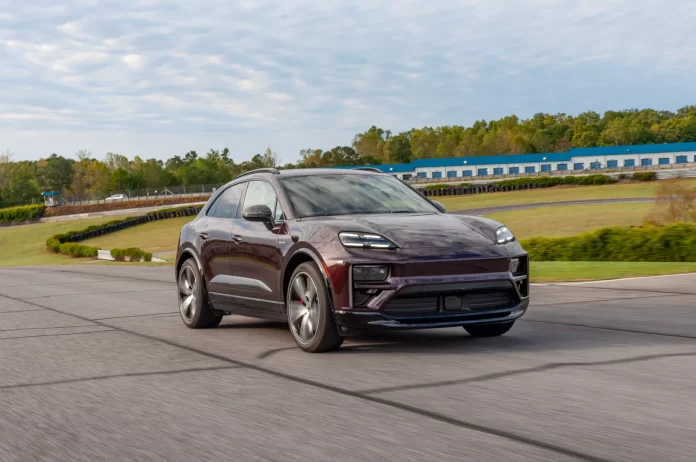- The Macan EV Turbo makes a whopping 630 hp from its two motors
- Porsche delivers on its signature handling prowess despite a lot of weight
- The dimensions grow slightly versus the gas model, but it doesn’t have much more space
Flogging the 2024 Porsche Macan EV Turbo through corners both flowing and tight on the 2.0 miles of Atlanta Motorsports Park, I’m struck by how different it is from its gas forebear but how similar it is as well.
The Turbo is the top model in the new Macan EV lineup and thus needs to be track-capable. Despite weighing in at 5,393 pounds—about 1,000 more than the current top gas model, the GTS—the Macan EV Turbo hunkers down through the sharp turn 4 carousel and remains stable in the faster, flowing lefthander that makes up turns 14 and 15. It’s track-ready, powerful, and has a familiar look. Seems like a next-generation Macan to me.
2024 Porsche Macan EV
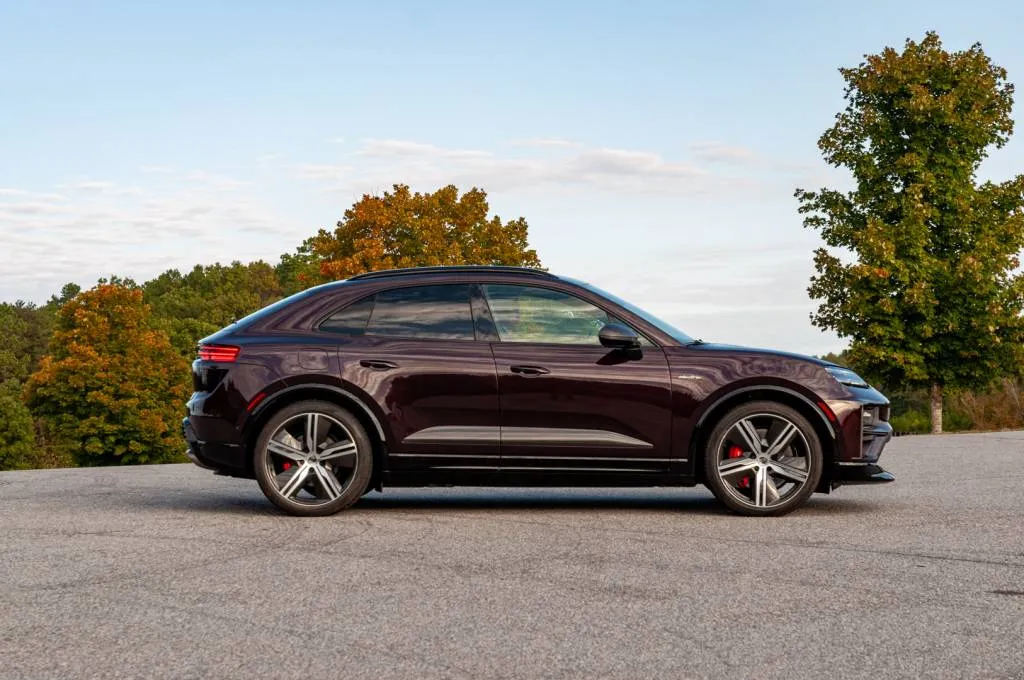
2024 Porsche Macan EV
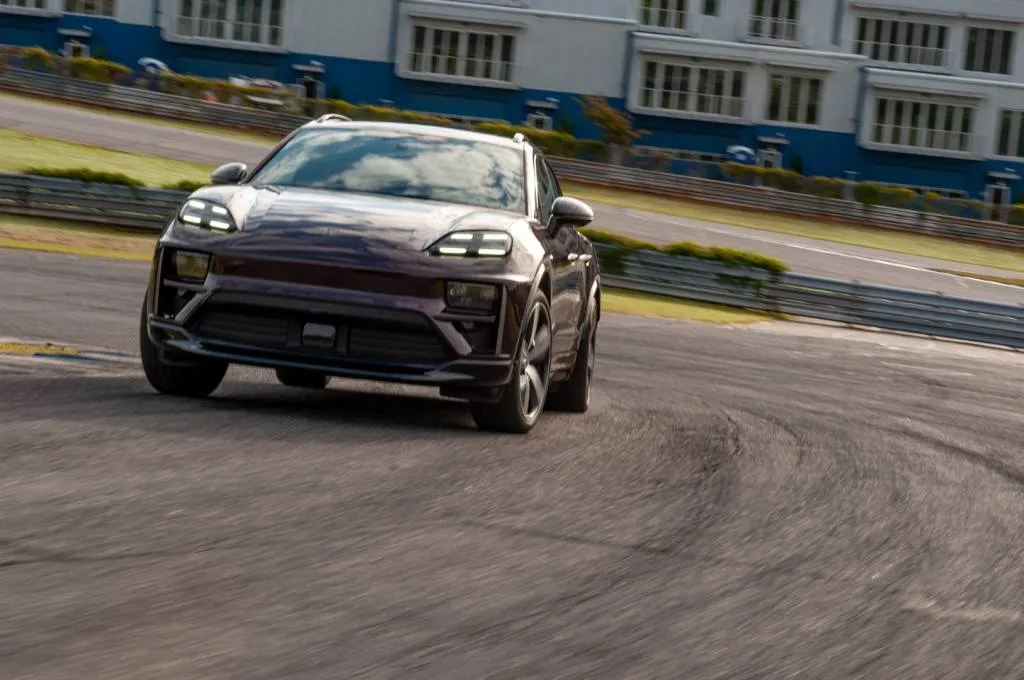
2024 Porsche Macan EV
Macan EV Turbo: New platform, similar feel
The Macan EV weighs so much because a big battery pack and electric motors weigh a lot more than an internal combustion engine, transmission, gas tank, and related components. All Macan EVs ride on VW Group’s new Premium Platform Electric (PPE) architecture, which is a skateboard platform for rear- and all-wheel-drive luxury vehicles.
The platform hosts a 100-kwh battery pack with 95 kwh of usable capacity that sits below the floor, as well as an electric motor in the rear and, in most cases, one in front as well. Like they did with the gas Macan a decade ago, Porsche engineers optimized the platform for performance, though this time around they were involved in its development from the start.
The Macan EV comes loaded with standard and optional goodies to help it handle like a Porsche. The standard features include a four-corner air suspension, adaptive dampers, and an electronically controlled locking rear differential. The two-motor setup enables the Porsche Traction Management all-wheel-drive system, which comes standard on the Turbo. This Turbo tester also gets the optional rear-wheel steering that can turn the rear wheels up to 5 degrees opposite of the fronts in low-speed maneuvers and with the fronts at higher speeds to aid stability.
My Turbo tester also rides on a set of optional 255/40R22 front and 295/35R22 rear Pirelli P Zero Corsa summer performance tires; 20-inch wheels are standard, as are all-season tires. To complete the performance upgrades, stopping power is provided by a standard set of 14.8-inch front rotors with 6-piston calipers (an inch larger than the base model with two extra calipers) and 13.8-inch rear rotors with single-piston floating calipers.
The PPE architecture and the performance parts give the Macan EV Turbo some advantages over the gas model as well as some disadvantages.
The most obvious detriment is all that weight. To a small extent on the track and even more so on the road, I can feel that weight shift each time I change directions. It adjusts quickly, but it’s not as subtle as the gradual lean you get in a gas model. From there, however, the Macan EV takes a set, leans little, and feels planted, likely because the weight of the battery is set so low. Quick, direct steering with a 14.2:1 ratio makes that weight shift more noticeable. It has electric assist and provides decent feel but not as much as you get in the 911.
The Macan EV Turbo tracks predictably through turns as well, without the understeer you’d expect given so much weight, and letting off the throttle midway through turn 4 induces a touch of lift-off oversteer to help the front end tuck in and the vehicle rotate. That’s not bad given a standard 7.2 inches of ground clearance that drops to 6.7 inches in the most track-appropriate Sport+ setting. A well-balanced 48:52 front-to-rear weight ratio contributes to that behavior. Compared to other PPE models, Porsche engineers flipped the rear motor 180 degrees to improve the weight distribution and provide space for the rear steering rack to run between the motor and battery.
The other issue involves the tires. During six or seven five-lap sessions (including a cool-down lap), the Pirelli P Zero Corsa tires provide good grip, aiding that stable feel through turns 14 and 15. However, they don’t last long, and they begin to wear and fray near the edges late in the day, which turns into bubbling once they sit while the vehicle is charging. Our editorial team has the same problem with the same tires on the Hyundai Ioniq 5 N, so at this point we can’t be certain if it’s a problem caused by the weight of an EV, the tires themselves, or both.
The brakes and cooling, however, come as a pleasant surprise. While the front brakes are big, the rear brakes aren’t and they only have single-piston calipers. However, the Macan’s motors can provide up to a little less than half a G of regenerative braking, and the brakes manage to hold up the whole day without fading or overheating. Same goes for the cooling. I was worried that this EV would need long periods of rest and a recharge between track sessions, but each session saps about only about 9% of the battery, and the battery and motors never get too hot.
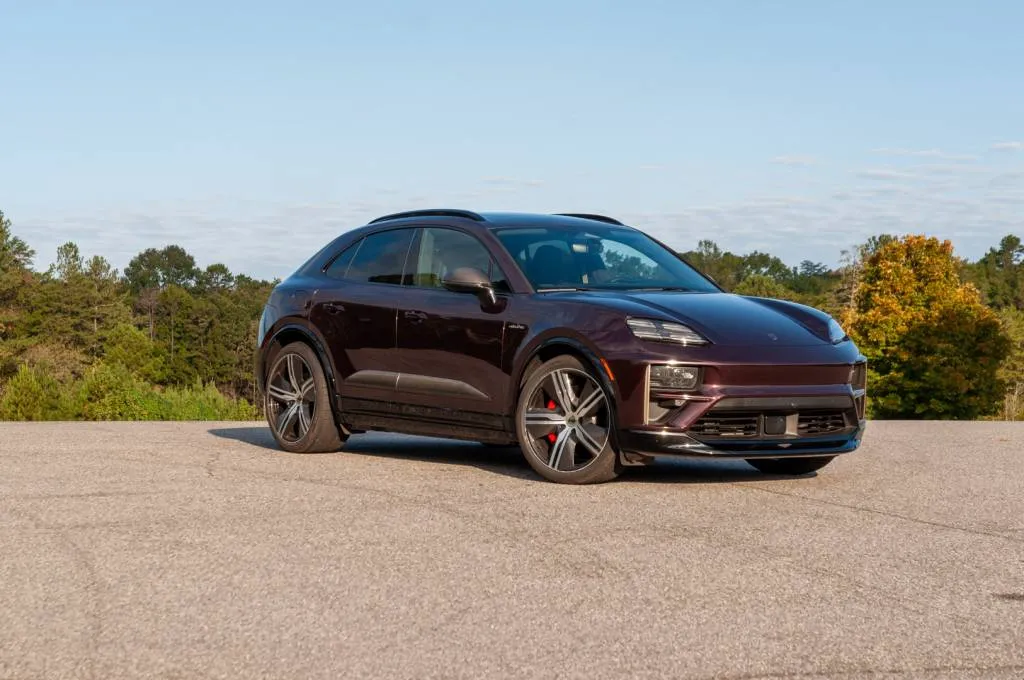
2024 Porsche Macan EV

2024 Porsche Macan EV
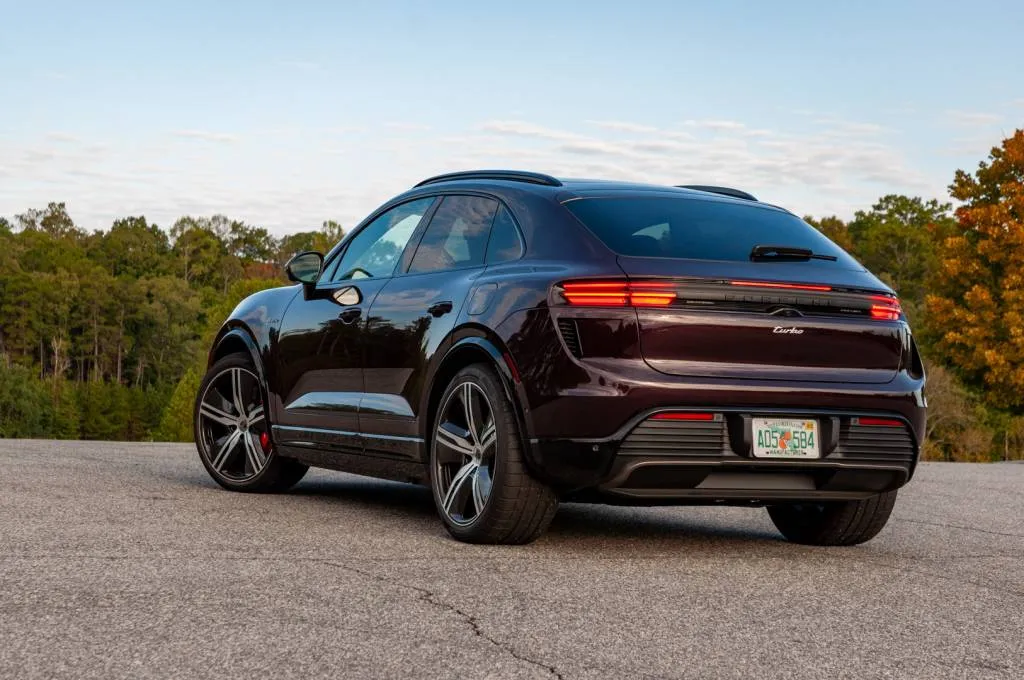
2024 Porsche Macan EV
Macan EV Turbo: Power to spare
This electric crossover’s main advantage over a gas model is its power. It uses a pair of permanent magnet synchronous motors, one on each axle, that combine to make 576 hp and 811 lb-ft of torque, numbers that climb as high as 630 hp and 833 lb-ft with overboost with launch control. Overboost is available for 10-second spurts, and is consistently available once again every time I let off the throttle for corners.
That compares to 434 hp and 405 lb-ft for the gas Porsche Macan GTS model. The Turbo’s 0-60 mph sprint takes just 3.1 seconds versus 4.1 seconds for the GTS, and the Macan EV Turbo tops out at 161 mph without the need for a 2-speed transmission for the rear motor like in the Taycan.
On the track, the power comes on immediately, though without upsetting the vehicle balance. It’s incredibly strong, and it unlocks a 121-mph top speed heading down the front straight into turn 1. It’s thrilling and sudden, and it’s much stronger than the gas model. The only issue is the sound. Drivers have a choice of no sound, or an optional Porsche Electric Sport Sound for $490, which has the spaceship-like whir used by several EVs these days. While the optional sound seems appropriate for an EV, it can’t match the throaty growl of a twin-turbo V-6 and certainly isn’t as appealing as the sonorous note of a Porsche flat-6.
When the motors lap up the power, the battery can be charged via ports on both sides of the vehicle. An 800-volt driver-side port fast-charges at up to 270 kw, given a connector capable of delivering that or more. At its peak road-trip-charging performance, it can add 155 miles in 10 minutes or charge from 10-80% in 21 minutes. If you hook up to a 150-kw outlet, the system will treat the 800-volt battery as two 400-volt batteries, adding 75 miles in 10 minutes or charging from 10-80% in 33 minutes. That makes it faster than it would be if it treated the battery as a single 800-volt unit. It can also charge at 11 kw on a Level 2 home charger, which will take about 10 hours to go from 0-100%.
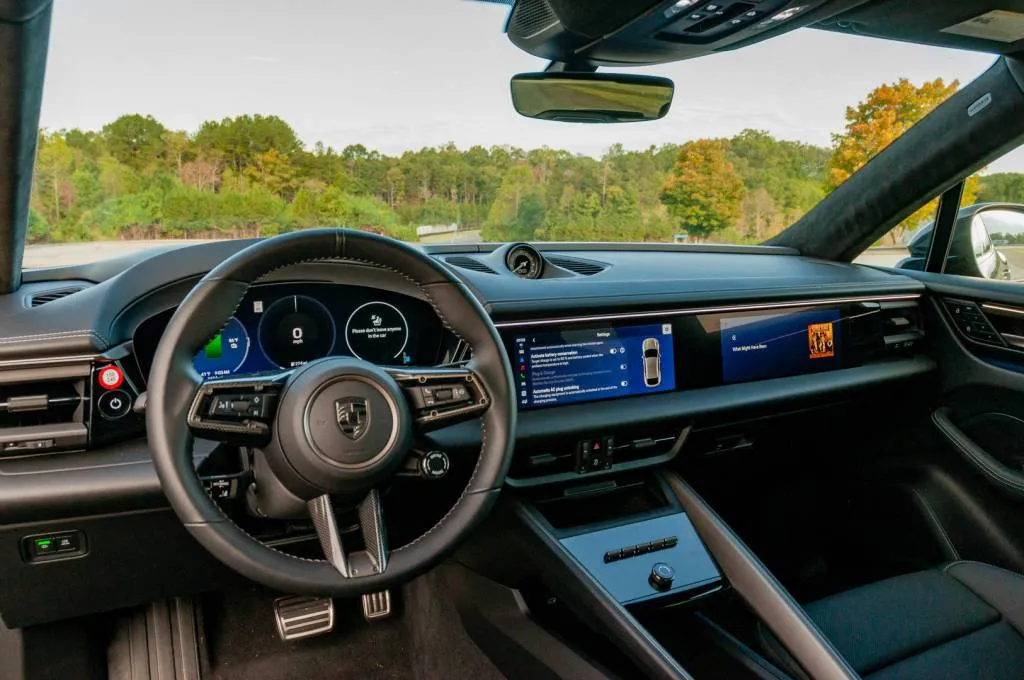
2024 Porsche Macan EV
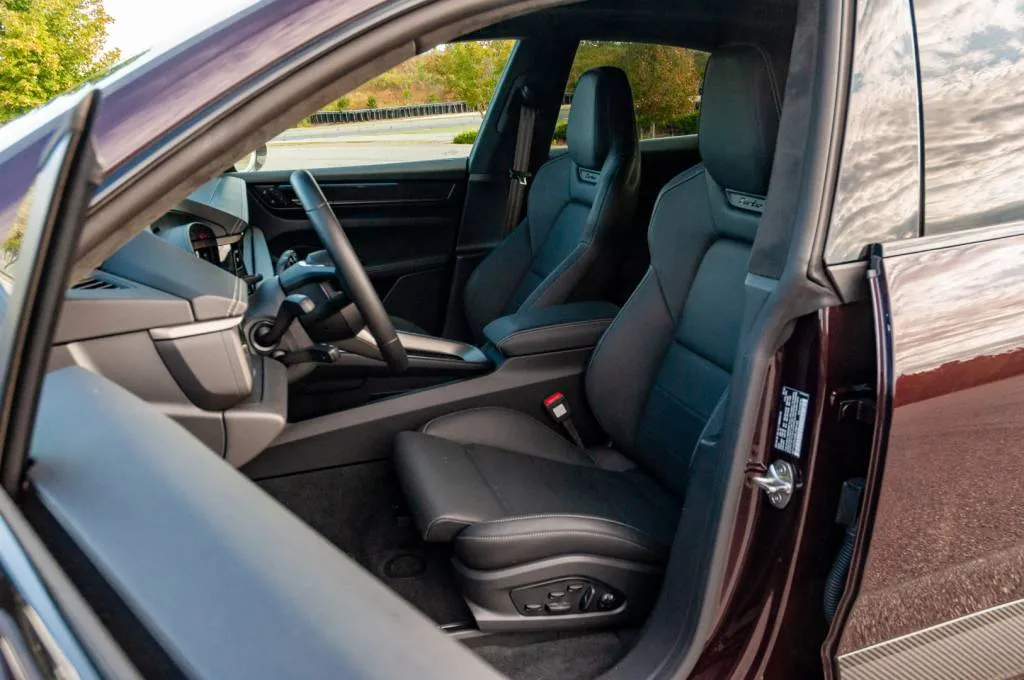
2024 Porsche Macan EV

2024 Porsche Macan EV
Porsche Macan EV: Next-generation looks and tech
Take a look at the Macan EV and you can tell what it is. It has the sloped rear roof pillar of the gas model, as well as the short wheelbase, the wheels-to-the-corners stance, the big wheels and tires, and the signature side blades. The front and rear fascias and lighting elements look sleeker and more modern, and the surfacing is cleaner. It all adds up to a slippery 0.25 coefficient of drag.
Inside, the Macan EV moves the connected technology forward compared to the gas model but in a way that would be expected for a new vehicle. It has a standard 12.6-inch digital instrument cluster and a 10.9-inch center touchscreen. Also offered are a 10.9-inch touchscreen for the front passenger and a head-up display with augmented reality overlays. The front passenger screen allows riders to control the music, navigation, and phone functions, as well as other apps.
All of the available apps are grouped in an app center on the infotainment screen. These include wireless Apple CarPlay and Android Auto, the Sport Chrono timers, the My Porsche app, and any streaming provider or smart home apps. Porsche also provides a cloud-based charging planner that the company says works more effectively than a native version.
Traditional controls follow the lead of the Cayenne SUV and Panamera hatchback gas models. The shifter is a small, knurled lever on the dashboard behind the steering wheel, and the Macan EV retains a start button to the left of the steering wheel, though some EVs forego start/stop buttons entirely.
Space isn’t much better than in the gas model. The Macan EV Turbo comes standard with leather upholstery, 8-way power-adjustable front seats, heated front seats, and a heated steering wheel. Between the small-diameter steering wheel and the good range of motion of the front seats, occupants will be comfortable and well supported. The back seat seems no more spacious than it is in the gas model. An average-size adult male will fit behind himself, but 6-footers will want more headroom and legroom. I’d expect more rear seat space given the fact that the EV’s 113.9-inch wheelbase is 2.4 inches longer than that of the gas model.
Cargo space is down slightly from the gas model, too, despite the fact that the electric model is about 2.3 inches longer at 188.4 inches. The Macan EV Turbo has 15.8 cubic feet behind the rear seat and 44.4 cubes with the rear seat down. That’s a little over 2 cubic feet less than other Macan EVs because the standard Bose audio system’s subwoofer and amplifier claim some space. All Macan EVs trail the gas version’s 17.7 and 53.8 cubes, respectively. A small 2.9-cubic foot frunk helps make up for some of that difference.
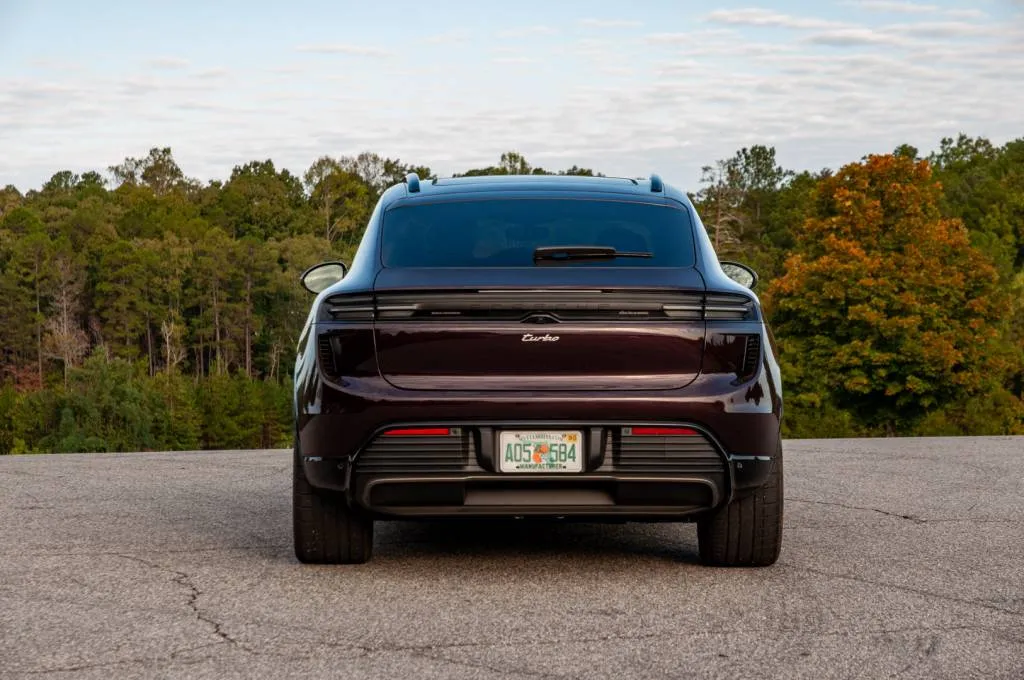
2024 Porsche Macan EV
The Macan Turbo starts at $107,295, including a $1,995 destination charge. My tester, however, checks in at $130,760 thanks such options as its Copper Ruby Metallic paint ($2,490), rear-wheel steering ($2,040), the Sport Chrono Package ($980), 22-inch Exclusive Design wheels with carbon-fiber aeroblades ($7,410), the InnoDrive driver-assist system ($960), the passenger display screen ($1,570), the augmented reality head-up display ($2,520), and the Premium Package $1,300) with four-zone automatic climate control, cooled front seats, and heated rear seats.
Those who don’t want the crazy power of the Macan EV Turbo can also choose the the 402-hp all-wheel-drive Macan 4 for $80,795. Porsche has already added two new models for the 2025 model year, the 335-hp base Macan EV with rear-wheel drive for $77,295, and the 509-hp Macan 4S, also with AWD, for $86,895. Those prices, on average, are about $4,000-$12,000 more than a comparable gas model, but Porsche buyers are pretty familiar with price increases in recent years.
No matter which Macan EV you choose, you can rest assured that it’s still a Porsche. It may not make the great sounds of other Porsches, but it’s likely faster, almost as agile, roughly as spacious, and it looks the part.

